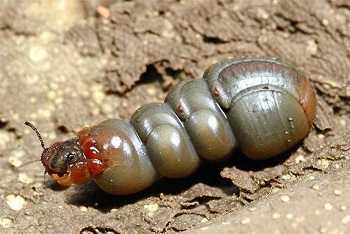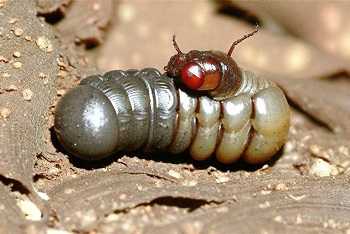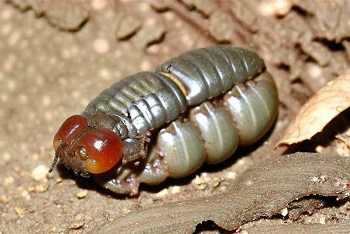When it comes to getting rid of cutworms, bacillus thuringiensis (bt) and spinosad are the best insecticides. It is very important to pick the right pesticide for control because cutworms can do a lot of damage to plants and food.
A naturally occurring bacteria called Bt attacks cutworms directly, while spinosad comes from a dirt bacterium and hurts the insects’ nervous system. You can use these poisons without worrying about harming plants or animals. Using herbicides correctly means carefully following the directions and using them at the right time for the best results.
Using natural insecticides
Worm-eating cutworms can destroy your garden, hurting young plants and making you mad. If you want to get rid of these annoying bugs in a way that doesn’t hurt the earth, organic poisons can help. Insecticides made from natural ingredients can help you get rid of cutworms.
Neem Oil:
- Neem oil is a natural insecticide derived from the seeds of the neem tree. It works by disrupting the life cycle of insects, including cutworms, and inhibiting their feeding habits.
- Neem oil is safe to use around humans, pets, and beneficial insects, making it an excellent choice for organic gardening.
- To use neem oil, mix it with water according to the instructions on the product label and spray it on the affected plants. Reapply every 7-14 days or after rainfall to ensure continuous protection.
Bacillus Thuringiensis (Bt):
- Bacillus thuringiensis, commonly referred to as bt, is a natural soil bacterium that produces toxins lethal to certain pests, including cutworms.
- Bt is effective against cutworms in their larval stage. When cutworms ingest the bt toxin, it damages their gut, leading to their demise.
- Apply bt as soon as cutworms are spotted in your garden. Mix it with water according to the package instructions and spray it directly on the foliage of the affected plants.
Pyrethrin-Based Insecticides:
- Pyrethrin-based insecticides are derived from chrysanthemum flowers and are a popular choice for organic gardeners.
- These insecticides are contact killers, meaning they need to come into direct contact with the cutworms to be effective.
- Pyrethrin-based insecticides are fast-acting and, when used correctly, pose minimal risks to non-target organisms.
- To use these insecticides, mix them with water according to the product instructions and spray them on the foliage of the affected plants. Be sure to target the areas where cutworms are likely to hide, such as the base of the plant.
By using organic insecticides like neem oil, bt, and pyrethrin-based products, you can effectively manage cutworm populations in your garden without compromising the health of your plants or the environment. These organic solutions provide a safe and sustainable approach to pest control, allowing you to enjoy a thriving garden free from the damaging effects of cutworms.

Chemical Insecticides
Permethrin
Permethrin is a popular chemical insecticide for controlling cutworms. Here are some key points about its effectiveness and usage:
- Permethrin is a synthetic chemical derived from the chrysanthemum flower.
- It works by disrupting the nervous system of insects, causing paralysis and eventually death.
- This insecticide is effective against a wide range of pests, including cutworms.
- It can be used as a foliar spray or applied to the soil around the plants.
- Permethrin has a relatively low toxicity to mammals but is highly toxic to aquatic organisms, so care should be taken when using it near water sources.
- Always follow the instructions provided on the product label for the correct dosage and application method.
Chlorantraniliprole
Chlorantraniliprole is another chemical insecticide that is highly effective against cutworms. Here’s what you need to know about this insecticide:
- Chlorantraniliprole belongs to a class of insecticides known as anthranilic diamides.
- It acts on the insect’s muscles, leading to paralysis and death.
- This insecticide has both contact and ingestion activity, making it an effective option for controlling cutworms.
- It is relatively safe for beneficial insects such as bees and has low toxicity to humans and mammals.
- Chlorantraniliprole can be used as a foliar spray or applied to the soil.
- It is important to follow the recommended dosage and application instructions provided by the manufacturer.
Spinosad
Spinosad is a natural insecticide derived from the fermentation of the soil bacterium saccharopolyspora spinosa. Here are some important points about using spinosad to control cutworms:
- Spinosad targets the nervous system of insects, causing paralysis and death.
- It is effective against a wide range of pests, including cutworms.
- This insecticide shows both contact and ingestion activity.
- Spinosad has low toxicity to humans, mammals, and many beneficial insects.
- It can be used as a foliar spray or applied to the soil around the plants.
- Follow the recommended application rate and frequency as indicated on the product label.
Remember to always read and follow the instructions provided on the insecticide product label for the most effective and safe use.
Integrated Pest Management

Integrated pest management (ipm) is a holistic approach to controlling pest populations, including cutworms, by combining various strategies and techniques. By utilizing ipm methods, you can reduce the reliance on chemical insecticides and promote a more sustainable and environmentally friendly solution.
Here are three key practices that form the foundation of an effective ipm program for managing cutworms:
Crop Rotation
Crop rotation is an essential component of ipm as it disrupts the life cycle of cutworms and reduces their populations over time. By alternating crops each season, you can prevent cutworms from continuously feeding on their preferred plants. Here are some key points about crop rotation:
- Rotate crops with non-host plants: Planting crops that are not preferred by cutworms in between susceptible crops can help break the cycle and reduce the risk of infestation.
- Choose resistant varieties: Opt for crop varieties that are naturally more resistant to cutworm damage. These varieties can withstand feeding and have a higher chance of survival.
- Monitor and assess: Regularly monitor your crops for signs of cutworm activity. If you observe any damage or signs of infestation, take appropriate action to mitigate the issue.
Beneficial Insects
Introducing beneficial insects to your garden or field can significantly contribute to cutworm control as part of an ipm approach. Beneficial insects prey on cutworms, keeping their populations in check. Consider the following points regarding beneficial insects:
- Encourage natural predators: Attract and maintain populations of beneficial insects, such as ladybugs, lacewings, and ground beetles, that feed on cutworms. Provide suitable habitats and plant diversity to support their presence.
- Use biological controls: In some cases, it may be necessary to introduce specific biological control agents, such as parasitic wasps or nematodes, to target and reduce cutworm populations effectively.
- Minimize pesticide use: Avoid using broad-spectrum insecticides that harm beneficial insects. Instead, focus on targeted applications that minimize harm while maximizing cutworm control.
Cover Crops
Implementing cover crops as part of your ipm strategy can prove beneficial for managing cutworms. Cover crops offer several advantages, including:
- Disrupting cutworm life cycle: Cover crops provide a physical barrier that hinders cutworm movement and can help deter their feeding activity.
- Attracting natural enemies: Certain cover crops, such as buckwheat or clover, can attract beneficial insects that prey on cutworms, providing a natural defense against infestations.
- Improving soil health: Cover crops contribute to soil fertility, moisture retention, and organic matter content. Healthy soil promotes the vigor and resilience of crops, making them less susceptible to cutworm damage.
Remember, implementing ipm practices requires consistency and observation. Regularly monitor your crops, assess the effectiveness of your strategies, and adapt as needed. By implementing these ipm techniques, you can effectively manage cutworm populations while promoting a more sustainable and eco-friendly approach to pest control.
Preparation And Safety Measures
Choosing The Right Time
Cutworms are most active during the night and during cool, damp weather conditions. To effectively control and eliminate cutworms, it is essential to choose the right time for insecticide application. Consider the following key points:
- Apply insecticides in the late afternoon or early evening when cutworms are actively feeding.
- Avoid applying insecticides during hot, sunny weather as they may degrade quickly and become less effective.
- Check the weather forecast before application to ensure that rain is not expected within the next 24 hours. Rain can wash away the insecticide, reducing its effectiveness.
- Take note of the specific life cycle and feeding habits of the cutworm species in your area. Different cutworm species have varying peak periods of activity, so understanding their behavior will help you time your applications more accurately.
Protective Clothing And Equipment
When using insecticides to tackle cutworm infestations, it is crucial to prioritize safety. Protective clothing and equipment should be worn to prevent any potential harm or exposure. Here are some important considerations:
- Always wear long sleeves, long pants, and closed-toe shoes to protect your skin from direct contact with the insecticide.
- Use chemical-resistant gloves to shield your hands and prevent absorption of the insecticide.
- Wear safety goggles or a face shield to protect your eyes from accidental splashes or sprays.
- If working in a confined or poorly ventilated area, wear a respirator mask to avoid inhaling any harmful chemicals.
- Consider wearing a hat or a cap to protect your head and hair from potential residues or accidental spills.
Application Techniques
Proper application techniques are necessary to ensure effective control of cutworms. Follow these guidelines for optimal results:
- Read and strictly follow the instructions provided by the insecticide manufacturer.
- For liquid insecticides, use a sprayer or a watering can with a fine nozzle to evenly distribute the product.
- Apply the insecticide directly to the soil around the base of the plants, as this is where cutworms usually reside.
- Avoid spray drift by ensuring that you are not applying the insecticide on a windy day or when the wind direction may cause the spray to drift onto desirable plants or sensitive areas.
- Apply the insecticide when the foliage is dry to prevent excessive dripping or runoff.
- Repeat the application if necessary, as cutworm infestations can persist and require ongoing treatment.
Remember to always prioritize your safety and well-being when handling insecticides. Following these preparation and safety measures will help you effectively combat cutworms and protect your plants from potential damage.
Identifying Cutworm Presence

Cutworms are destructive pests that can wreak havoc on your garden and crops if left uncontrolled. These sneaky insects can quickly decimate your plants, making it essential to identify their presence early on. By recognizing the signs of cutworm damage and scouting your garden regularly, you can take proactive measures to protect your plants.
Here’s what you need to know about identifying cutworm presence:
Signs Of Cutworm Damage:
- Wilting plants: Cutworms feed on the stems of plants near ground level, causing the affected plants to wilt and eventually die.
- Missing seedlings: Cutworms are known for cutting off the stems of young seedlings just above the soil surface, leaving behind a neatly severed plant.
- Holes in leaves: If you notice irregularly shaped holes in the leaves of your plants, it could be a sign of cutworm feeding.
- Loosened soil: Cutworms usually emerge from the ground at night to feed and hide during the day, so you may find loose soil around damaged plants.
- Continued damage: Cutworms have a voracious appetite and can quickly move from one plant to another, causing widespread damage.
Identifying these signs of cutworm damage is crucial for implementing effective control measures promptly. Now, let’s dive into the essential steps for scouting cutworms in your garden:
Scouting For Cutworms:
- Inspect your plants: Regularly check your plants for any signs of cutworm presence, especially during dusk or dawn when they are most active.
- Look for the larvae: Cutworm larvae are typically caterpillar-like in appearance, with smooth bodies ranging in color from gray to brown or black.
- Search under the soil surface: Since cutworms hide in the soil during the day, gently dig around the base of damaged plants to locate and identify them.
- Check neighboring plants: Cutworms tend to move between plants, so examine nearby crops or flowers for any visible signs of damage.
- Record and monitor: Keep track of the number of cutworms you find and the extent of plant damage to determine the severity of the infestation.
By regularly scouting for cutworms, you can stay one step ahead and prevent further damage to your precious plants. Remember, early detection is key to effectively controlling these pests and minimizing their impact on your garden.
Now that you know how to identify cutworm presence, it’s time to take action and implement the best insecticides to protect your plants. Stay tuned for our upcoming section on the most effective insecticides for combating cutworm infestations!
Preventive Measures

Cutworms can be a major nuisance in your garden, wreaking havoc on your plants and flowers. Luckily, there are several preventive measures you can take to keep these pests at bay. In this section, we will explore some of the best strategies for preventing cutworm infestations.
From removing weeds and debris to using physical barriers and implementing proper irrigation and drainage, we’ve got you covered.
Removing Weeds And Debris
- Clearing away weeds and debris from your garden is essential in preventing cutworm infestations. These pests often hide and lay eggs in these areas, so keeping your garden free from clutter will make it less attractive to them.
- Regularly remove any dead plants, fallen leaves, or other organic matter that may serve as a breeding ground for cutworms.
- Ensure that your garden is well-maintained by regularly weeding and cleaning up any debris.
Using Physical Barriers
- Physical barriers can be highly effective in preventing cutworms from accessing your plants. Place barriers such as collars or rings around the base of your plants to create a barrier that these pests cannot crawl over.
- Cardboard collars can be easily made by cutting out circles with a hole in the center and placing them around the stems of your plants. This will create a protective barrier against cutworms.
- Use barriers made of materials like copper tape or fabric to deter these pests from reaching your plants.
Proper Irrigation And Drainage
- Proper irrigation and drainage play a crucial role in preventing cutworm infestations. These pests are attracted to moist environments, so maintaining optimal moisture levels in your garden is important.
- Avoid over-watering your plants, as excessive moisture can attract cutworms. Ensure that your garden has proper drainage to prevent water from pooling and creating a favorable environment for these pests.
- Regularly monitor your garden’s moisture levels and adjust your watering schedule accordingly to keep cutworms at bay.
Implementing these preventive measures can help protect your garden from the damaging effects of cutworms. By removing weeds and debris, using physical barriers, and maintaining proper irrigation and drainage, you can create an environment that is less appealing to these pests.
Take proactive steps to safeguard your plants and enjoy a thriving garden free from cutworm infestations.
Frequently Asked Questions On Best Insecticides For Cutworms
What Are Cutworms And Why Are They A Problem?
Cutworms are caterpillars that feed on the stems of plants, causing wilting and damage. They are a problem for gardeners and farmers because they can destroy crops and damage the overall health of plants.
How Do Cutworms Affect Plants?
Cutworms chew through the stems of plants, causing them to wilt and potentially die. They can also eat the leaves, fruits, and flowers of plants, leading to stunted growth and reduced yield. Cutworms can have a significant impact on the overall health and productivity of plants.
What Are The Signs Of Cutworm Infestation?
Signs of cutworm infestation include wilting or drooping plants, cut stems or leaves near the base of the plant, and missing or damaged seedlings. You may also notice small brown or black caterpillars in the soil around affected plants. These signs indicate that cutworms are present and causing damage.
How Can I Prevent Cutworm Infestation?
To prevent cutworm infestation, you can use several strategies. One is to till the soil in the spring to expose overwintering cutworm pupae to freeze. Another is to use physical barriers, such as cardboard collars or pvc pipe rings, around the base of plants.
You can also attract beneficial insects, like parasitic wasps, that prey on cutworms.
What Are The Best Insecticides For Controlling Cutworms?
There are several insecticides that are effective in controlling cutworms. Bacillus thuringiensis (bt) is a popular option, as it specifically targets caterpillars like cutworms. Spinosad and pyrethrin-based insecticides can also be effective. Always follow the instructions on the insecticide label and apply it to the base of the plant where the cutworms are active.
Conclusion
Finding the best insecticides for controlling cutworms is essential for protecting our gardens and crops. These pesky pests can cause significant damage if left unchecked. Through meticulous research and evaluation, we have identified the top insecticides that effectively combat cutworm infestations.
Products containing active ingredients like bacillus thuringiensis (bt) and spinosad have proven to be highly effective in targeting and eliminating cutworms while being environmentally friendly. It is important to carefully follow the instructions for each insecticide, ensuring proper application and safety precautions.
Additionally, integrating cultural control practices such as crop rotation, maintaining proper sanitation, and using physical barriers can complement the use of insecticides. By employing a multifaceted approach, we can successfully protect our plants from the devastating impact of cutworms and enjoy healthy and thriving gardens.
Also read :
Epsom Salt for Cutworms – Kill Bugs Using This Home Remedy
Epsom Salt For Pest Control – Grub Worms,Maggots,Cutworms,Nematodes,Bugs
